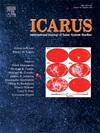New candidate cave entrances on the Moon found using deep learning
IF 2.5
2区 物理与天体物理
Q2 ASTRONOMY & ASTROPHYSICS
引用次数: 0
Abstract
Pits and skylights are circular to elliptical, rimless, steep-sided depressions on planetary surfaces formed through gravitational collapse, which are of interest for astrobiological investigation and future space exploration. This is due to their ability to signify the presence of, or allow access to, underground cave systems such as lava tubes. The Lunar Pit Atlas contains 16 such features situated within mare regions that were partly discovered via the automated PitScan tool, which was limited by searchable latitudes and data coverage. In order to search for pits and skylights within these unmapped regions, we have trained a series of Mask R-CNN (Region-based Convolutional Neural Network) models on various combinations of Lunar and Martian remote-sensing imagery to detect Lunar pits and skylights. The best-performing model, named ESSA (Entrances to Sub-Surface Areas), was trained upon all available training data with a ResNet50 backbone. During testing on imagery of the famous Mare Tranquillitatis Pit and self-produced mosaics of proposed lava tube collapses, ESSA achieved average F-scores of 82.4 and 93.7% for the bounding boxes and predicted masks, respectively. Despite only having surveyed 1.92% of the Lunar maria, ESSA has detected two previously uncatalogued skylights: the South Marius Hills and Bel’kovich A Pits (SMHP and BAP) - which are possible candidates for cave entrances on the Moon.
利用深度学习发现了月球上新的候选洞穴入口
凹坑和天窗是行星表面由引力坍缩形成的圆形到椭圆形、无框、陡峭的凹陷,对天体生物学研究和未来的太空探索很有兴趣。这是由于它们能够表明地下洞穴系统(如熔岩管)的存在或允许进入。月球坑地图集包含16个这样的特征,这些特征部分是通过自动坑扫描工具发现的,该工具受到可搜索纬度和数据覆盖范围的限制。为了在这些未映射的区域内搜索凹坑和天窗,我们在月球和火星遥感图像的各种组合上训练了一系列Mask R-CNN(基于区域的卷积神经网络)模型来检测月球凹坑和天窗。表现最好的模型名为ESSA(入口到地下区域),使用ResNet50骨干网在所有可用的训练数据上进行训练。在对著名的Mare Tranquillitatis Pit图像和自制的熔岩管崩塌马赛克图像进行测试时,ESSA的边界框和预测掩模的平均f1得分分别为82.4和93.7%。尽管只调查了约1.92%的月玛丽亚,ESSA已经发现了两个以前未被分类的天窗:南马里乌斯山和贝尔科维奇A坑(SMHP和BAP)——它们可能是月球上洞穴入口的候选者。
本文章由计算机程序翻译,如有差异,请以英文原文为准。
求助全文
约1分钟内获得全文
求助全文
来源期刊

Icarus
地学天文-天文与天体物理
CiteScore
6.30
自引率
18.80%
发文量
356
审稿时长
2-4 weeks
期刊介绍:
Icarus is devoted to the publication of original contributions in the field of Solar System studies. Manuscripts reporting the results of new research - observational, experimental, or theoretical - concerning the astronomy, geology, meteorology, physics, chemistry, biology, and other scientific aspects of our Solar System or extrasolar systems are welcome. The journal generally does not publish papers devoted exclusively to the Sun, the Earth, celestial mechanics, meteoritics, or astrophysics. Icarus does not publish papers that provide "improved" versions of Bode''s law, or other numerical relations, without a sound physical basis. Icarus does not publish meeting announcements or general notices. Reviews, historical papers, and manuscripts describing spacecraft instrumentation may be considered, but only with prior approval of the editor. An entire issue of the journal is occasionally devoted to a single subject, usually arising from a conference on the same topic. The language of publication is English. American or British usage is accepted, but not a mixture of these.
 求助内容:
求助内容: 应助结果提醒方式:
应助结果提醒方式:


